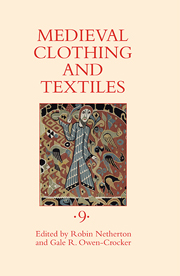Book contents
- Frontmatter
- Contents
- Illustrations
- Tables
- Contributors
- Preface
- 1 Bridal Gifts in Medieval Bari
- 2 The Marriage of the Year (1028)
- 3 Clothing as Currency in Pre-Norman Ireland?
- 4 Cistercian Clothing and Its Production at Beaulieu Abbey, 1269–70
- 5 Clothing and Textile Materials in Medieval Sweden and Norway
- 6 The Iconography of Dagged Clothing and Its Reception by Moralist Writers
- 7 Domestic Painted Cloths in Sixteenth-Century England: Imagery, Placement, and Ownership
- Recent Books of Interest
- Contents of Previous Volumes
7 - Domestic Painted Cloths in Sixteenth-Century England: Imagery, Placement, and Ownership
Published online by Cambridge University Press: 05 July 2013
- Frontmatter
- Contents
- Illustrations
- Tables
- Contributors
- Preface
- 1 Bridal Gifts in Medieval Bari
- 2 The Marriage of the Year (1028)
- 3 Clothing as Currency in Pre-Norman Ireland?
- 4 Cistercian Clothing and Its Production at Beaulieu Abbey, 1269–70
- 5 Clothing and Textile Materials in Medieval Sweden and Norway
- 6 The Iconography of Dagged Clothing and Its Reception by Moralist Writers
- 7 Domestic Painted Cloths in Sixteenth-Century England: Imagery, Placement, and Ownership
- Recent Books of Interest
- Contents of Previous Volumes
Summary
Of all the common pieces of interior domestic decoration to be found in the households of sixteenth-century England, the stained or painted cloth wall hanging was the most ubiquitous. From the cottages of poor widows to the homes of city merchants, from the halls of country farmers to the palaces of princes, these movable household furnishings could be found everywhere. In 1577, William Harrison wrote in his Description of England, “The wals of our houses on the inner sides … be either hanged with tapisterie, arras worke, or painted cloths, wherin either diverse histories, or hearbes, beasts, knots, and such like are stained ….” Such household furnishings were to a great extent hanging storybooks that told tales both entertaining and edifying. On the practical side, painted cloths covered blank walls, kept out drafts, brightened a room, offered ornament, and lent an air of status and gentility to upwardly aspiring families. More profoundly, through painted combinations of words and images, these cloths provided a delivery system for instruction in the cultural idiom and the transference of approved societal memes. Among the more affluent, the display of heraldic devices or clan-specific emblems put the stamp of family ownership on a particular living space. More than any other household object, the nation's hanging cloths illustrated in readily understandable forms the eidos or cultural sum of its intellectual character and spiritual beliefs.
- Type
- Chapter
- Information
- Medieval Clothing and Textiles 9 , pp. 139 - 160Publisher: Boydell & BrewerPrint publication year: 2013



